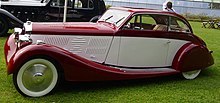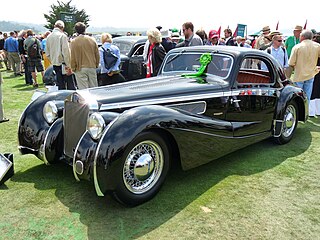
Letourneur & Marchand, located in the prosperous Paris suburb Neuilly-sur-Seine, was a car body manufacturing business which became one of the last French coachbuilders.

Letourneur & Marchand, located in the prosperous Paris suburb Neuilly-sur-Seine, was a car body manufacturing business which became one of the last French coachbuilders.
The company was founded by Jean-Marie Letourneur and Jean-Arthur Marchand in 1905. Both originally came from the French region of Burgundy and came to Paris independently of each other shortly before the beginning of the 20th century. Since 1900, Letourneur had worked as a designer for the established carriage manufacturer Binder Carrossier in Neuilly-sur-Seine, which Marchand also joined shortly afterwards after completing his training as a wheelwright. In April 1905, Letourneur and Marchand separated from Binder. Together they took over the premises of the previously insolvent body construction company Wehrle Godard Desmaret and set up their own business there.
Initially, Letourneur et Marchand worked primarily as a subcontractor for other coachbuilders, including Binder, Franay and Labourdette. In 1907 the company began producing individual bodies based on customer requirements; The design for the bodies came from Jean-Marie Letourneur. By the outbreak of the First World War, over 1,200 bodies had been built. During the war, the production of automobile bodies came to a standstill. Letourneur et Marchand was primarily a supplier to the armaments industry until 1918; Among other things, parts of aircraft bodies were created here.

In 1924 the company created a subsidiary called Autobineau to specialise in sedan and limousine car bodies produced in greater volumes and in a slightly more standardised format than was associated with the upmarket coach builders. During the 1920s Letourneur et Marchand became the main supplier of car bodies for Delage. The business also built bodies for manufacturers such as Unic. In just a few years, Autobineau produced 2,000 more or less identical bodies for the Delage DI. In addition, there were still individual bodies that were created at the customer's request. Since the 1930s, Letourneur et Marchand worked primarily for Delage. In 1936, Delage introduced their D8-120 chassis, which formed the basis for the Aérosport, manufactured between 1936 and 1939, for which both Letourneur and Autobineau produced a number of bodies. [1] The company also dressed chassis from Buick, Duesenberg, [2] Renault, Delahaye, Panhard, Rolls-Royce and Bugatti. By the outbreak of the Second World War, at least 19 bodies had been built for the Bugatti Type 57. From 1930 onwards, the design of the bodywork was predominantly in the hands of Marcel Letourneur, a son of the company's founder, who had received artistic training and worked for several British coachbuilding companies in the 1920s. Marcel Letourneur often created aerodynamically designed bodies that had a low beltline and did without a central vehicle pillar in order to make the roof structure appear lighter. An outstanding example of this design style was Marcel Letourneur's Coupé Panoramique from 1937, which was built on a Delage D6 chassis. [3] The company also manufactured similar bodies for chassis from other manufacturers, including Lincoln.
During the Second World War, automobile production again came to a standstill. The founders of the company died shortly before (Jean-Marie Letourneur, 1944) or after the end of the war (Jean-Arthur Marchand, 1946). After the war, their successors tried to restart operations but, like their competitors Saoutchik and Figoni et Falaschi, failed due to changing circumstances. This included, among other things, France's economic weakness in the early post-war years, which meant that demand for exclusive luxury vehicles was very limited. The former business partner Delage, who had already been absorbed into the Delahaye company before the war, finally stopped production in 1953. In addition, automobile manufacturers switched to self-supporting bodies, which made it harder to manufacture custom bodies for cars. Letourneur et Marchand also found themselves one of numerous auto-businesses far too small to feature significantly in the government's vision for an export led French auto-industry dominated by a handful of large manufacturers. Between 1947 and 1952 the company produced only 67 car bodies, [4] equivalent to about one car per month. Immediate financial collapse was averted in 1953 thanks to a contract signed with Renault for the production of a cabriolet version of the Renault Frégate which had been homologated with the authorities and could be sold and serviced through one of France's largest dealership networks. [4] Unfortunately the Frégate itself had got off to a slow start in the market place, being beset by teething problems and reliability issues, and although sources indicate that during the second half of the decade it became a much more dependable vehicle, in terms of sales volumes it was hopelessly out competed by the Simca Vedette and the Citroën DS. The Frégate struggled on till 1960 when it was withdrawn without direct replacement, and during this time 70 Letourneur et Marchand cabriolet variants were produced. [4] The final batch of Frégate cabriolets featured an eye catching two tone paint scheme, coloured either "black and ivory" or "black and turquoise". [4]
Letourneur & Marchand collapsed in 1960 following the discontinuation of their cabriolet version of the Renault Frégate.

Delage is a French luxury automobile and racecar company founded in 1905 by Louis Delâge in Levallois-Perret near Paris; it was acquired by Delahaye in 1935 and ceased operation in 1953.

A coachbuilder or body-maker is a person or company who manufactures bodies for passenger-carrying vehicles. Coachwork is the body of an automobile, bus, horse-drawn carriage, or railway carriage. The word "coach" was derived from the Hungarian town of Kocs. A vehicle body constructed by a coachbuilder may be called a "coachbuilt body" or "custom body".

The Bugatti Type 41, better known as the Royale, is a large luxury car built by Bugatti from 1927 to 1933, With a 4.3 m (169.3 in) wheelbase and 6.4 m (21 ft) overall length, it weighs approximately 3,175 kg (7,000 lb) and uses a 12.763 litre (778 cu in) straight-eight engine. For comparison, against the Rolls-Royce Phantom VII, the Royale is about 20% longer, and more than 25% heavier. This makes the Royale one of the largest cars in the world. Furthermore, with the limited production run and the premium nature of the vehicle, it is also both one of the rarest and most expensive.

Abbey Coachworks Limited was a British coachbuilding business based in Merton, South West London and later Acton, North West London. It was active between 1930 and 1938.

Carrosserie Pourtout was a French coachbuilding company. Founded by Marcel Pourtout in 1925, the firm is best known for its work in the decades prior to World War II, when it created distinctive and prestigious bodies for cars from numerous European manufacturers. Pre-war Pourtout bodies were mainly one-off, bespoke creations, typically aerodynamic and sporting in character. Together with chief coach designer and stylist Georges Paulin from 1933 to 1938, Pourtout pioneered the Paulin invented 'Eclipse' retractable hardtop system on four models of Peugeot, several Lancia Belna's and other car makes.
Among the company's customers was Georges Clemenceau, the physician and journalist who served as the prime minister of France from 1906 to 1909 and 1917 to 1920.
The Dana Point Concours d'Elegance is an automotive charitable event held each year on the Monarch Beach Golf Links at the Monarch Beach Resort Resort in Dana Point, California. It is operated primarily as a Classic Car Club of America (CCCA) Concours, with additional classes showcasing interesting and relevant automobiles and motorcycles. The 2010 event was held Sunday, June 27, 2010 moving from its traditional date in September.

The Delahaye Type 175 is a coachbuilt luxury automobile manufactured by French automaker Delahaye. Production build numbers were formally recorded from early 1948 to mid 1951, validating that 107 cars were built in the mechanically cloned three wheelbase series comprising the Types 175/175S, 178 and 180.

The Delahaye 135 is a luxury car manufactured by French automaker Delahaye. Designed by engineer Jean François, it was produced from 1935 until 1954 in many different body styles. A sporting tourer, it was also popular for racing.

Saoutchik was a French coachbuilding company founded in 1906 and based in Neuilly-sur-Seine near Paris. The company was one of the best-known coachbuilders in France in the 1920s and 1930s and, together with Figoni et Falaschi and Franay, is considered one of the most important representatives of the "Baroque" style in French coachwork in the 1930s and 1940s.

Graber was a Swiss coachbuilder based in Wichtrach. Between 1927 and 1970 the firm supplied coach-built bodies for fitting on the chassis of various European and US auto-makers. Graber had a particularly close relationship with the British firm of Alvis, providing the manufacturer with bespoke and elegant if expensive bodies for almost twenty years, mostly during the 1950s and 1960s.
France was a pioneer in the automotive industry and is the 11th-largest automobile manufacturer in the world by 2015 unit production and the third-largest in Europe. It had consistently been the 4th-largest from the end of World War II up to 2000. It is 16% of sales of French manufactured products.
The Renault Suprastella is a large car that was introduced by Renault in the Spring of 1938 as a replacement for the Renault Nervastella from which it inherited its mechanical elements and many other essential characteristics.
Automodello is a manufacturer of resin-cast hand-built models in a variety of scales. The company is headquartered in Buffalo Grove, Illinois.
Figoni et Falaschi is a French luxury brand and coachbuilder firm which was active from 1935 through to the 1950s. The designs were created by Giuseppe Figoni, while his partner Ovidio Falaschi ran the business.

Carrosserie Vanvooren was a French Coachbuilder based in the north-western Paris suburb of Courbevoie. The company concentrated on producing car bodies for luxury cars, being closely associated, during the 1930s, with the products of Hispano-Suiza, Bugatti, Rolls-Royce and Bentley.

The Delage D6 is a six-cylinder luxury car produced by the manufacturer between 1930 and 1940 and again, after the war, between 1946 and 1953. For much of this time it was the company’s principal or, from 1946, only model.

The Delage D8 was an eight-cylinder luxury car produced by Delage between 1929 and 1940.
Franay was a French coachbuilder operating at Levallois-Perret, a suburb on the prosperous north-western edge of Paris. The company was founded in 1903 by Jean-Baptiste Franay, a carriage upholsterer, following an apprenticeship with Binder. It was later taken over by his son, Marius. Franay car body production stopped in late 1955.
Pichon-Parat was a French carrosserie based in the commune of Sens, in the department of Yonne. Established in 1952, it was known for producing custom cabriolet, coupé, estate car, and shooting brake conversions of established models from major automakers, and for building their own distinctive sporting models with completely original bodywork.
Antem Carrossier was a French coachbuilding company that, in the period between the world wars and a short time afterwards, produced one-off bodies for luxury car chassis, as well as some bodies in small series production.